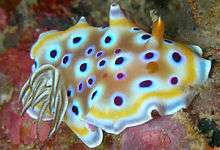Goniobranchus geminus
Goniobranchus geminus, also known as the gem sea slug[3], is a species of very colourful sea slug, a dorid nudibranch, a marine gastropod mollusc in the family Chromodorididae.[2]
| Goniobranchus geminus | |
|---|---|
 | |
| Scientific classification | |
| Kingdom: | Animalia |
| Phylum: | Mollusca |
| Class: | Gastropoda |
| Subclass: | Heterobranchia |
| Order: | Nudibranchia |
| Suborder: | Doridina |
| Superfamily: | Doridoidea |
| Family: | Chromodorididae |
| Genus: | Goniobranchus |
| Species: | G. geminus |
| Binomial name | |
| Goniobranchus geminus | |
| Synonyms[2] | |
| |
Taxonomic history
Until 2012 this species was known as Chromodoris geminus but was moved to the genus Goniobranchus as a result of a molecular (DNA) study.[4]
Description
Goniobranchus geminus can reach a maximum size of 5 cm in length.[5] It has four distinctive coloured lines around the mantle edge. Starting from a thin white outer line, then a light grayish line, followed by another white line and finally a bright golden yellow line.[6] The background coloration from the back is light brown to yellowish speckled with mauve ocelli circled with a white margin. The foot, clearer and with a white margin, also has ocelli. The rhinophores are yellow or purple and laminated, gills are white outlined with beige.[7]
Distribution and habitat
This sea slug lives in the Indian Ocean from Kenya to Sri Lanka and in the Red Sea and has a predilection for the external slopes of coral reefs.[5]
Similar species
- Goniobranchus kuniei (Pruvot-Fol, 1930).
- Goniobranchus leopardus (Rudman, 1987).
- Hypselodoris tryoni (Garrett, 1873).
- Goniobranchus tritos (Yonow, 1994).
References
- Rudman W. B. (1987). "The Chromodorididae (Opisthobranchia: Mollusca) of the Indo-West Pacific: Chromodoris epicuria, C. aureopurpurea, C. annulata, C. coi and Risbecia tryoni colour groups". Zoological Journal of the Linnean Society 90: 305-407. doi:10.1111/j.1096-3642.1987.tb01357.x
- Bouchet, P. (2012). Goniobranchus geminus. Accessed through: World Register of Marine Species on 2012-05-03
- King, Dennis; Fraser, Valda (2014). The Reef Guide: fishes, corals, nudibranchs and other invertebrates (of the) East and South Coasts of Southern Africa. Cape Town: Struik Nature. p. 316. ISBN 9781775840183.
- Johnson R.F. & Gosliner T.M. (2012) Traditional taxonomic groupings mask evolutionary history: A molecular phylogeny and new classification of the chromodorid nudibranchs. PLoS ONE 7(4): e33479.
- Rudman, W.B., 1999 (January 22) Chromodoris geminus Rudman, 1987. [In] Sea Slug Forum. Australian Museum, Sydney.
- Gosliner, T.M., Behrens, D.W. & Valdés, Á. (2008) Indo-Pacific Nudibranchs and seaslugs. A field guide to the world's most diverse fauna. Sea Challengers Natural History Books, Washington, 426 pp. page(s): 220
- Debelius, H. & Kuiter, R.H. (2007) Nudibranchs of the world. ConchBooks, Frankfurt, 360 pp. ISBN 978-3-939767-06-0 page(s): 164
External links
- Photos of Goniobranchus geminus on Sealife Collection